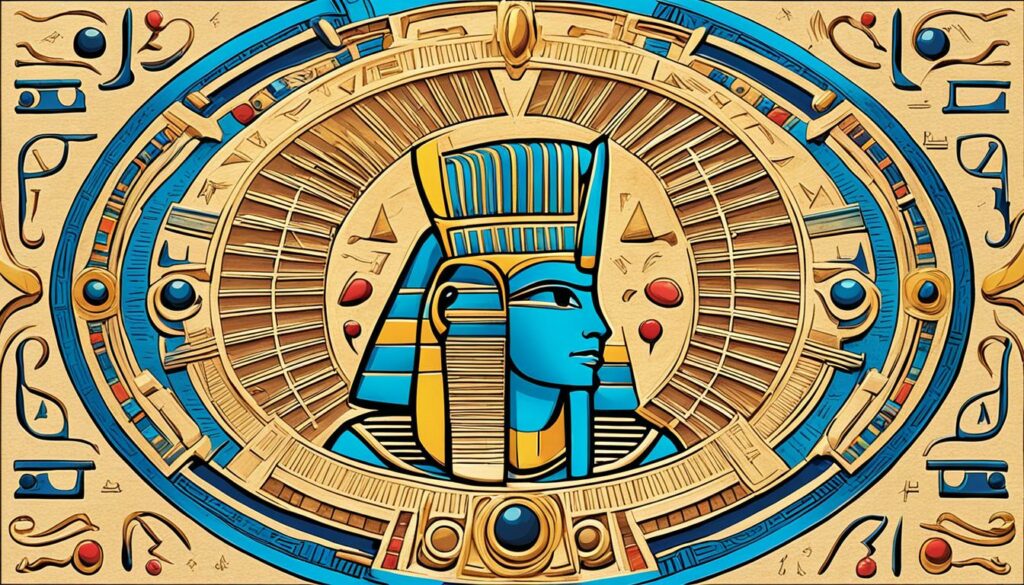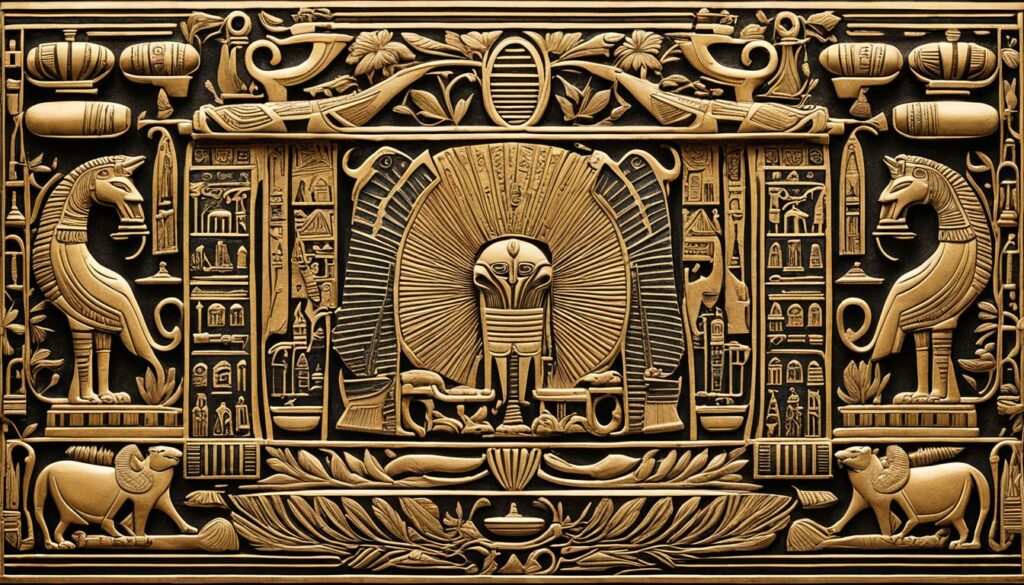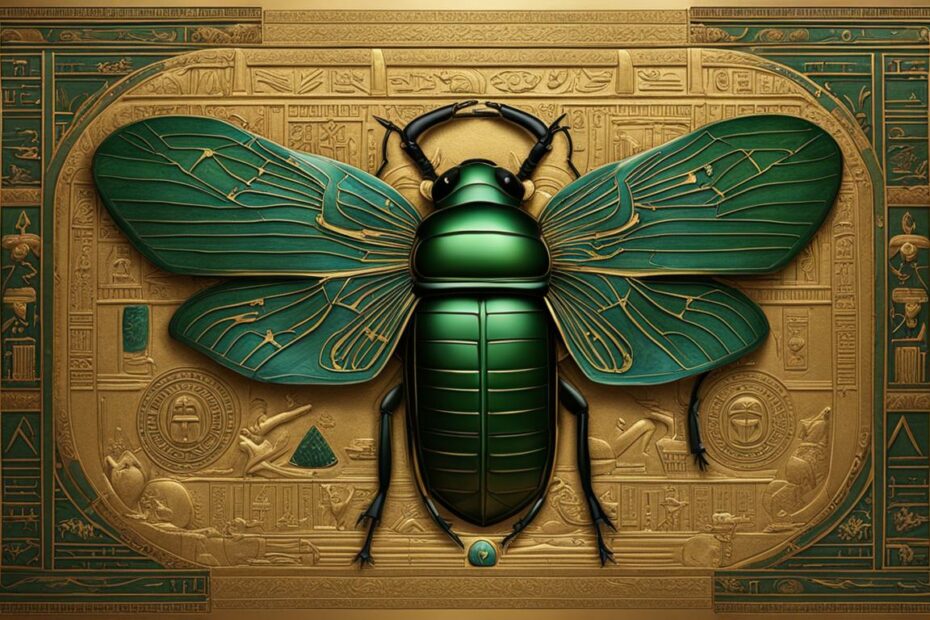In ancient Egypt, the cartouche held great significance. A cartouche was an oval symbol that contained the name of a pharaoh, symbolizing their rule of the cosmos. It was believed to bring good luck and protection against evil. Moreover, the cartouche played a crucial role in the ancient Egyptian writing system, which consisted of hieroglyphic symbols.
These ancient Egyptian symbols, including the cartouche, adorned temples, tombs, and other important structures. They represented the power and sovereignty of the pharaohs and connected them to the gods. The cartouche’s prominent presence in ancient Egyptian culture underlined its importance in conveying divine lineage and legitimacy.
The Meaning and History of the Egyptian Cartouche
In ancient Egypt, the cartouche, known as “shenou” in their language, held great significance. It was an oval shape with a line drawn perpendicular to the bottom, symbolizing a pedestal. Designed to accommodate the inscription of a pharaoh’s name, the cartouche represented their power and divinity. It played a crucial role in legitimizing their rule and establishing their connection to the gods.
Over time, the cartouche became associated with protection against evil and was believed to bring good luck. Its influence extended beyond pharaohs, as wealthy individuals also incorporated cartouches into their tombs. These ancient Egyptian royal names, enclosed within cartouches, showcased the lineage and divine connection of the pharaohs.

The Symbolic Names in Ancient Egypt Cartouches
Egyptian cartouches played a significant role in ancient Egypt, containing the symbolic names of pharaohs and other important figures. These names were enclosed within cartouches to signify the pharaoh’s divine lineage and connection to the gods. The cartouche, an oval-shaped symbol, represented the pharaoh’s power and sovereignty, linking them to the gods.
A cartouche typically contained the last two of the five titularies of a pharaoh: the prenomen (throne name) and the “Son of Ra” titulary (birth name). This use of symbolic names in cartouches showcased the pharaoh’s divine status and solidified their connection to the gods of ancient Egypt. However, it’s essential to note that cartouches were not limited to pharaohs alone; gods and other significant figures in Egyptian history could also have their names enclosed within cartouches.
The symbolic names within cartouches offered profound insights into the ancient Egyptian culture and their belief system. They represented the divine nature of the pharaohs and their role as the earthly representatives of the gods. These cartouches served as a visual reminder of the pharaoh’s power, sovereignty, and connection to the gods of Egypt.
Ancient Egyptian Symbols and Their Meanings
Ancient Egyptian symbols were deeply intertwined with the culture and history of the civilization. Each symbol had its own significance and meaning, contributing to the rich tapestry of Egyptian mythology and belief system. The cartouche, with its enclosed symbolic names, was just one of many symbols that held immense importance in ancient Egypt.
Other iconic Egyptian symbols included the ankh, representing life and eternity; the scarab beetle, symbolizing rebirth and transformation; and the Eye of Horus, representing protection and healing. These symbols, like the cartouche, represented different aspects of Egyptian life and belief. They were often depicted in various forms of art, architecture, and religious rituals.
Studying ancient Egyptian symbols provides a glimpse into the depth of their spirituality, culture, and history. It allows us to understand the significance these symbols held in the lives of the ancient Egyptians and their enduring legacy.
The Origin of the Term “Egyptian Cartouche”
The term “cartouche” originated from the observations made by French soldiers during their interactions with ancient Egyptian artifacts. They noticed the resemblance between the oval shape of the cartouche symbol and the paper powder cartridges used in their guns. This similarity led to the term “cartouche” being coined and widely used to refer to the oval symbols containing the names of pharaohs and other important figures in ancient Egypt.
The adoption of the term “cartouche” further enhanced the association between the symbol and Egyptian culture. It became intrinsically tied to the enigmatic world of hieroglyphs and the rich history of ancient Egypt. Today, the term “Egyptian cartouche” is recognized worldwide as one of the most iconic symbols of this ancient civilization.

The image above showcases an example of an Egyptian cartouche, emphasizing its distinct oval shape and the hieroglyphic inscriptions contained within. The cartouche symbolizes the power, authority, and divinity of the pharaohs in ancient Egypt.
| Origins of the Term | Symbolism and Association | Recognition and Legacy |
|---|---|---|
| The term “cartouche” was coined by French soldiers. | The Egyptian cartouche became associated with Egyptian culture and the mysteries of hieroglyphs. | The symbol is recognized as one of the most iconic symbols of ancient Egypt. |
| It was inspired by the oval shape of paper powder cartridges used by French soldiers. | The cartouche symbolizes the power, protection, and divinity of the pharaohs. | The term “Egyptian cartouche” gained worldwide recognition. |
| The term is now widely used to refer to ancient Egyptian oval symbols. | The association with hieroglyphs and ancient Egypt strengthened its symbolic significance. | It continues to captivate and fascinate individuals interested in ancient Egyptian history. |
Overall, the origin of the term “Egyptian cartouche” highlights the cross-cultural connections and influences that have contributed to our understanding and appreciation of ancient Egyptian symbols. The continued recognition and legacy of the cartouche serve as a testament to the enduring allure and fascination surrounding ancient Egyptian history.
The Hieroglyphs Within Egyptian Cartouches
The hieroglyphs within Egyptian cartouches played a pivotal role in the ancient Egyptian writing system. These intricate symbols represented the names of pharaohs or gods and were a key element in conveying messages and preserving historical records.
The ancient Egyptian writing system consisted of a set of 24 hieroglyphic letters, each representing a specific sound or meaning. These hieroglyphic letters were combined to form words and sentences, allowing the ancient Egyptians to express complex ideas and narratives.
Within the context of cartouches, hieroglyphs were used to write the names of pharaohs or gods enclosed within the oval symbol. The cartouche acted as a protective boundary, preserving and showcasing the divine lineage and power of the individual or deity.
Additionally, cartouches could also contain hieroglyphs representing numbers, indicating the order in which a pharaoh used their name. This provided valuable insights into the chronology and succession of rulers in ancient Egypt.
The deciphering of hieroglyphs posed a significant challenge for scholars until it was eventually achieved by Jean-François Champollion in the early 19th century. His breakthrough allowed for a deep understanding of the ancient Egyptian writing system and the intricate meanings encoded within cartouches.
The Significance and Legacy of Egyptian Cartouches
Egyptian cartouches hold significant cultural and historical value. They are not only a representation of the pharaoh’s power and protection but also a testament to the intricate hieroglyphic writing system of ancient Egypt. The use of cartouches in ancient Egyptian history is a fascinating example of the ancient Egyptian symbols that continue to captivate the world today.
The ancient Egyptians believed that the cartouche served as a protective amulet for the pharaoh, shielding them from evil forces and ensuring their authority and divinity. It symbolized the king’s connection to the gods and the cosmic order. This powerful symbol could be found in temples, tombs, and other significant structures, serving as a physical representation of the pharaoh’s rule.
Today, the legacy of the cartouche lives on as a symbol of ancient Egypt and its rich civilization. It has become an enduring emblem of Egyptian culture and is recognized worldwide. Cartouche jewelry and decorative items inspired by these symbols are incredibly popular among those intrigued by the mysteries of ancient Egypt. They serve as a reminder of the ancient Egyptian writing system, which was instrumental in revealing the history and stories of this extraordinary civilization.
The significance of Egyptian cartouches extends beyond the realm of ancient history. They are a link to a bygone era, a window into a fascinating civilization that continues to amaze and inspire people around the world. Through the study and appreciation of these remarkable symbols, we gain a deeper understanding of the beauty, complexity, and ingenuity of ancient Egyptian culture and its contributions to human history.
FAQ
Q: What is a cartouche in ancient Egypt?
A: In ancient Egypt, a cartouche was an oval symbol that contained the name of a pharaoh. It represented the king’s rule of the cosmos and symbolized power and protection.
Q: What was the significance of a cartouche?
A: The cartouche was believed to bring good luck and ward off evil. It played a significant role in the ancient Egyptian writing system and could be found in important structures like temples and tombs.
Q: What did the hieroglyphic cartouche represent?
A: The hieroglyphic cartouche enclosed a pharaoh’s name, representing their divine lineage and connection to the gods of ancient Egypt. It symbolized the pharaoh’s power and sovereignty.
Q: Were cartouches only used by pharaohs?
A: No, cartouches were not limited to pharaohs. Gods and other important figures in ancient Egypt could also have their names enclosed within cartouches.
Q: Where did the term "cartouche" come from?
A: The term “cartouche” was coined by French soldiers who noticed the similarity between the oval shape of the cartouche symbol and the paper powder cartridges used in their guns.
Q: What did the hieroglyphs in a cartouche represent?
A: The hieroglyphs in a cartouche represented the names of pharaohs or gods. They were part of the ancient Egyptian writing system, comprising 24 hieroglyphic letters that represented specific sounds or meanings.
Q: What is the legacy of Egyptian cartouches?
A: Egyptian cartouches hold significant cultural and historical value. They not only represent the pharaoh’s power and protection but also showcase the intricate hieroglyphic writing system of ancient Egypt. Today, cartouche jewelry and decorative items inspired by these symbols are popular among enthusiasts of ancient Egyptian history.
